How Long Does It Take to Heal After a Fall?

Written on December 22, 2023.
Written by James J. Kirshbaum. Posted in Premises Liability.
A slip-and-fall can happen in an instant, but the recovery process can last months or even years. In particularly unfortunate cases, you may even suffer permanent damage in an accident. However, no matter how severe your injuries are, you deserve proper compensation.
Personal injuries of all kinds can be unexpected and traumatic, but slip-and-fall injuries are particularly troublesome, considering the responsibility of property owners to maintain safe conditions for people. Whether you suffered a slip-and-fall at a business or a private residence, you deserve compensation, and the time it takes you to recover should be taken seriously.
A Minnesota premises liability attorney can provide you with legal representation while striving for the compensation you deserve. At Kirshbaum Injury Law, we will be by your side for every step of the healing process.
How Does Minnesota Define Slip-and-Fall Accidents?
A slip-and-fall in Minnesota is legally defined as an injury that is suffered due to a defect in a piece of property that created dangerous conditions. A spill on the floor of a supermarket, for example, could lead to a customer slipping and breaking their wrist. That would be a slip-and-fall accident because the floors of a supermarket should be safe for customers. Surfaces that are covered in ice and snow can also be potentially dangerous if the property owner doesn’t keep their pathways clear.
The Slip-and-Fall Statute of Limitations in Minnesota
If you are filing a slip-and-fall claim in Minnesota, you must abide by the state’s statute of limitations, which is six years from the date of the accident. While this may seem like a long time relative to some other statutes of limitation, it is still important to file as soon as possible.
Slip-and-fall accidents are more common than you might think. According to the Centers for Disease Control and Prevention (CDC), more than a million Americans are hurt from slip-and-fall accidents every year, resulting in over 17,000 accidental deaths.
Types of Slip-and-Fall Accidents in Minnesota
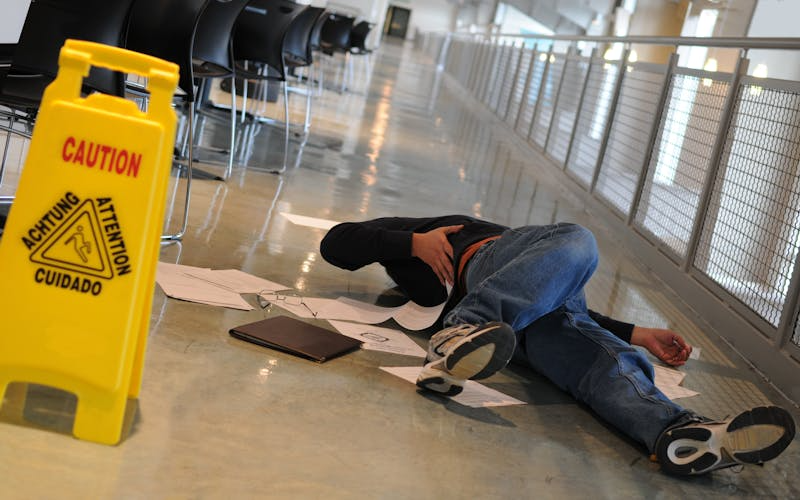
Slip-and-fall accidents can occur in many different settings in Minnesota, and they each have unique considerations to keep in mind, from minor injuries to more serious types of injuries.
Stores and Restaurants
Stores, restaurants, and other types of businesses that frequently have customers physically visiting the premises are common locations for slip-and-fall accidents. A floor could be wet from a spill or a leaking refrigerator, or entrance walkways could be slippery from winter slush. While not technically a slip, a trip-and-fall is legally treated the same way if you’re injured by equipment like boxes in walkways or worn carpets.
Personal Property
Slip-and-falls on personal property typically occur when you are visiting someone’s house or in their yard. When you are invited to someone else’s personal property, that invitation comes with the assumption that you will be able to traverse that property safely. Keep in mind, however, that you must be invited for this to apply. You cannot recover compensation for a fall you suffered while trespassing.
Warehouses and Workplaces
It is common for warehouse workers to fall and sustain injuries on the job, so companies are usually meticulous about their workplace safety practices. Even so, you may be entitled to workers’ compensation if you suffered a slip-and-fall at work.
Common Injuries Sustained in a Slip-and-Fall Accident
Slip-and-fall accidents can be more damaging than you might think. Here are some of the most common injuries in these kinds of accidents.
Neck Injuries
Injuries to the neck can be particularly severe, given that they can potentially lead to spinal cord damage.
Symptoms of Neck Injuries
- Nerve pain
- Headaches
- Muscle spasms
- Muscle pain
When to See a Doctor
You should see a doctor when your neck pain lasts for a long time without improvement or if your ability to move your neck and head is limited. Any kind of weakness in your arms may stem from a pinched nerve in your neck, which warrants medical attention.
Recovery Time Frame
The healing time for neck injuries depends on their severity. More extreme cases could have you facing months of recovery, while other kinds of neck pain will resolve in a matter of days. Seeing a doctor is the best way to determine your neck injury’s severity and recovery time.
Muscle Injuries and Tears
When you injure your muscles or suffer a muscle tear, the pain is only the beginning of the trouble, as your mobility could also be compromised.
Symptoms of Sprains or Strains of Muscles, Tendons, or Ligaments
- Muscle pain
- Tenderness in muscles
- Cramps and spasms
- Muscle “pop” during the injury
- A gap in the outline of the muscle
- Decrease in muscle strength or loss of function
- Muscle discoloration or swelling
When to See a Doctor
If your muscle pain does not improve after 48 hours, you should see a doctor. Some cases warrant immediate medical attention, like if you hear or feel a “pop” in your muscle during the injury. You should also see a doctor if your muscle is notably weak or difficult to move. You may also need to see a physical therapist.
Recovery Time Frame
For minor muscle sprains, you may find relief in as little as 48 hours. All symptoms may fade in a matter of two weeks or so. Back muscle pain tends to take longer to recover from, between four to six weeks. Severe muscle pain may last until the muscle is repaired surgically, and tissue damage can take months or longer to heal.
Concussions and Traumatic Brain Injuries (TBIs)
From concussions to traumatic brain injuries, head injuries are serious conditions you could suffer in the wake of a slip-and-fall.
Symptoms of Concussions and TBIs
- Headache
- Blurred vision
- Difficulty speaking
- Difficulty moving
- Nausea and vomiting
- Fatigue
- Drowsiness
- Dizziness
When to See a Doctor
You should see a doctor whenever you get a head injury of any kind. What you may think is a mild concussion could be a serious traumatic brain injury if left untreated, so seeing a doctor is paramount. Simply taking an over-the-counter anti-inflammatory and applying an ice pack is often not enough, so it is better to play it safe.
Recovery Time Frame
A mild concussion takes a few days to get over, but a traumatic brain injury can take much longer. In fact, more serious injuries can create lifetime conditions that victims have to learn to manage.
Broken Bones and Fractures
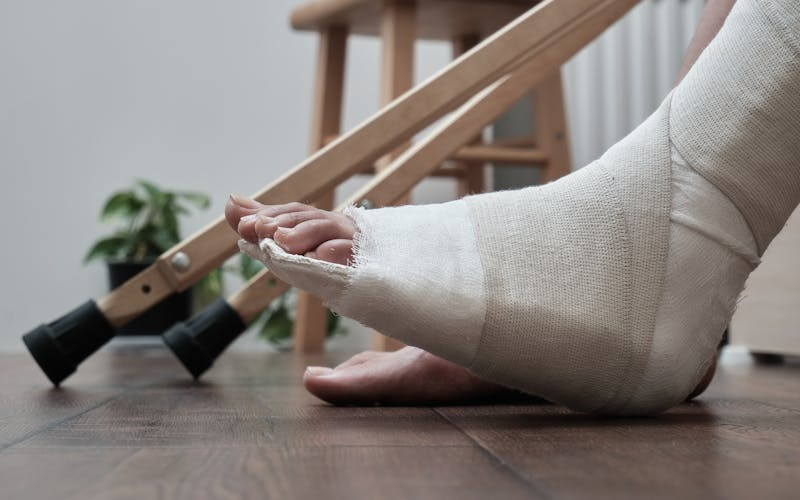
A broken bone can be incredibly painful and significantly limit mobility after a slip-and-fall.
Symptoms of Broken Bones and Fractures
- Sharp pain at the injury site
- Injured area is misshapen
- Inability to move affected part of your body
- Numbness or tingling in injured body part from interrupted blood flow
When to See a Doctor
You need to see a doctor for any instance in which you suffer a broken bone or fracture. Medical attention is necessary to help the affected bone heal correctly.
Recovery Time Frame
Broken bones typically take weeks to months to heal fully. However, the timeline for healing depends on the severity of the injury and which bone or bones were broken. In cases where surgery is required, recovery may take longer.
How Long After a Slip-and-Fall Accident Should I Be Sore?
Every slip-and-fall injury is unique, as are the people who suffer them. There is no universal answer to how long your soreness will last. Everyone’s body is different, as are their injuries. In general, fractured bones take a couple of months to heal, while severe injuries of a body part may take up to a year. New strength from soft tissue repair after a soft tissue injury can take more than a year to develop. Some injuries can last a lifetime.
What to Do Immediately After a Minnesota Slip-and-Fall Accident
In the wake of a slip-and-fall accident, here is what you should do:
- Seeking proper medical attention.
- Once any necessary emergency services are notified, do what you can to document the scene. Take photos of your injury and the property conditions that caused the injury, as this can serve as valuable evidence in your case.
- Call a Minnesota personal injury attorney to start your case.
Frequently Asked Questions About Minnesota Slip-and-Fall Accidents
How Long After a Fall Can I Claim a Suit?
From the date of the fall, you have six years to file a suit in the state of Minnesota.
How Are Damages Determined After a Slip-and-Fall Accident?
Damages are divided into economic and non-economic categories. Economic damages are easily quantifiable and include healthcare bills, X-rays, physical therapy, and lost wages. Non-economic damages are a bit more obscure because they reference emotional trauma and pain and suffering. A lawyer can help assign a reasonable figure for non-economic damages.
How Long Will It Take for My Personal Injury Case to Be Resolved?
The length of your case depends on how complex it is and the parties involved. These cases generally range from three to six months, but those that go to trial take much longer.
Your Trip-and-Fall Accident Matters. Are You Ready to File Suit?
With help from Kirshbaum Injury Law, you can focus on recovering from your injuries while we take care of your legal issues. We do not simply strive to win you compensation. We strive for the maximum compensation. Contact us today at 952-545-2700 or by filling out our online contact form for a free consultation with an experienced Minnesota premise liability attorney.

Written By James J. Kirshbaum
Jim is a very experienced trial lawyer having conducted jury trials in multiple states both on behalf of injured people and on behalf of defending insurance companies.
Schedule a Free Consultation with James J. Kirshbaum
I Fell at a Pool. What Should I Do?

Written on November 22, 2023.
Written by James J. Kirshbaum. Posted in Premises Liability.
Swimming pools, typically associated with relaxation, can unfortunately be sites of accidents and injuries. For those affected, swimming pool accidents not only result in physical harm but also lead to accumulating medical expenses and potential loss of income. Swimmers visit a pool with the expectation of having fun and do not realize an owner’s negligence can lead to life-changing accidents and serious injuries.
As days progress, the injured party may face escalating financial stress. The mounting bills can become a significant concern, especially when coupled with the physical recovery process. Additionally, there’s the matter of accountability. The party responsible for ensuring the pool’s safety may not always recognize or address their negligence, leading to a feeling of unresolved injustice.
This is where an experienced Minnesota premises liability attorney becomes crucial. If you are facing the aftermath of a pool injury, you should consult a premises liability attorney. Such guidance can offer a structured path toward resolution and relief. To schedule your free consultation, contact Kirshbaum Injury Law at 952-545-2700.
What Accidents Can Occur at a Swimming Pool in Minnesota?
Unfortunately, slip-and-fall accidents are a realistic risk in private and public pool areas as potential hazards are lurking in every corner. If you slip and fall at a pool and sustain an injury, it could be due to several reasons. Common causes of slip-and-fall accidents at Minnesota swimming pools include the following.
Diving Boards
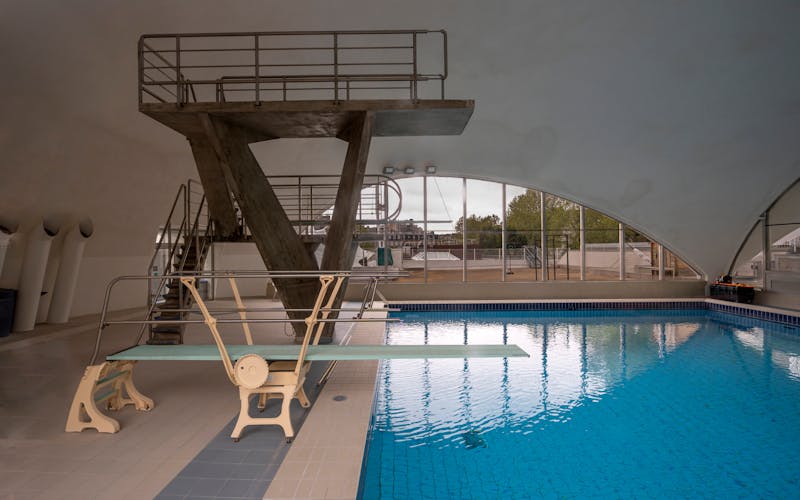
Diving boards are often slippery surfaces where people can unexpectedly slide off and hit the water, concrete, or deck below, leading to severe injury. You should exercise caution while on a diving board and dive properly. Owners also have a responsibility to inspect ladders and ensure no damage or flaw is affecting the safety of their diving board.
Shallow Pools
When a person slips and falls in the shallow side of a pool, they risk serious injury from striking their head on the pool’s bottom.
Pool Decks
A common area where swimming pool slips occur is on the deck. These tend to happen when the owner does not try to keep it dry. Falls on the wet surface of a deck are usually unexpected, and since the victim typically hits a hard surface, they can sustain severe head, neck, spine, and back injuries.
Falling Off a Ladder
Injuries from falling off pool ladders sometimes occur after a traction pad wears off and the owner does not replace it with a new slip-resistant pad. Owners have a responsibility to keep their pool equipment in safe working condition.
Poor Setup and Maintenance
Poor pool setup and maintenance is a primary cause of slips and falls at the pool. If an owner does not set up the pool’s equipment and surrounding area correctly, this creates unsafe conditions. If an owner fails to perform maintenance or make repairs, this can lead to slippery equipment or other dangerous conditions.
Electrocution
While rarer than slip-and-fall accidents in pool areas, electrocution sometimes occurs. If owners do not perform appropriate pool maintenance, wires, lighting, and other components may get wet or damaged, leading to hazardous conditions.
What to Do After Falling at a Pool in Minnesota
After suffering any type of personal injury, it is important to remember to not admit to having any fault in an accident. This includes suggesting you were clumsy, distracted, or not wearing the right footwear. In many cases, there are other circumstances you may not be aware of that could have led to your fall. Admitting fault or apologizing could undermine your personal injury claim later.
You should be very careful in what you say. Take the following steps to take care of your well-being, preserve the evidence, and protect yourself.
Seek Medical Attention
If you are injured, you should seek treatment from a healthcare provider immediately. Even if you do not feel hurt, you should still get yourself examined by a doctor. You may have injuries that are not immediately apparent, some of which might be serious. Additionally, if someone spent an extended period of time submerged in water from the accident, they should be examined by a doctor.
No matter the degree of injury or even if it appears no injuries are present, it is important that a physician documents your condition and examines you for unnoticed injuries. This will be important later, especially if you have a slip-and-fall injury accompanied by a stack full of medical bills.
File a Report
It can be difficult to report people you know or organizations you frequent, but it is vital your pool accident is on record and that you file a police report. Generating a report helps to preserve details and document evidence of what happened. If the owner or other responsible party was negligent, having an accident on record not only helps your case but can save someone else in the future from suffering serious injury.
Document the Scene
As soon as you can, document the accident scene at the pool. This is important, regardless of whether the pool is public or private. Owners or managers have a responsibility to keep pool areas safe from slippery surfaces and other hazards. Take photos and videos of the swimming pool and surrounding areas. If there are any loose concrete areas, puddles of water, loose cords, objects scattered on the ground, or other hazards, document them. Be sure to obtain the contact information for eyewitnesses who saw how you were hurt and can attest to pool conditions.
If you have to receive emergency medical attention, you can ask someone with you to handle this step.
Contact a Minnesota Premises Liability Attorney
To protect yourself, contact a personal injury attorney well-versed in Minnesota’s premises law. Never admit fault to the owner, pool manager, insurance company, or anyone else. Try to avoid talking to anyone about the accident until you consult with an experienced Minnesota premises lawyer.
Your attorney can investigate the accident and gather evidence. Your law firm can also serve as a go-between with the insurance company and negotiate on your behalf. Unfortunately, insurance companies notoriously try to undercut paying compensation for injuries and will try to get away with paying little to nothing.
What Are Some of the Most Common Injuries After Slips, Trips, and Falls?

The following is a list of common types of injuries that can result from a slip-and-fall at a swimming pool.
- Neck injuries
- Spine injuries
- Cuts and bruises
- Broken bones
- Traumatic brain injury (TBI)
Like other types of accidents, some injuries may surface immediately, while in other cases, a victim may suffer from hidden injuries that may not immediately be apparent.
Who is Liable For My Swimming Pool Accident in Minnesota?
If you fell at a pool in Minnesota, never assume you did something to cause your injury. Liability for your swimming pool injury may be the fault of another party. Their actions or inactions may be the direct cause of your injury. Your attorney can investigate the circumstances surrounding your fall and identify any parties at fault. Correctly identifying the causes of slip-and-falls and the liable person(s) for your injury is essential for your premises liability claim, especially if the reason for the fall was preventable.
Swimming Pool Owner
Pool owners have a responsibility to build, maintain, and manage their pools safely. Unfortunately, sometimes, owners are negligent and fail to perform necessary tasks to keep their pool areas safe. If so, they can be held liable for not exercising their duty of care.
A Lifeguard
Lifeguards help keep swimmers and others in the pool area safe. If someone is running, they will typically blow their whistle and order them to stop. Lifeguards are also tasked with keeping a close eye on the pool areas and water. If the lifeguard is distracted, fails to rescue someone, or neglects to ensure safe conditions at the pool, they can be held liable for injuries or wrongful death.
A Caretaker
Caretakers are individuals hired by pool owners to manage and maintain pools on the property. If the caretaker neglects to repair broken pool equipment, perform maintenance, or otherwise keep a pool area safe, they may be found negligent and at fault for an accident. This includes ensuring lifeguards are also not working in unsafe conditions.
How Do I Prove My Slip-and-Fall Case in Minnesota?
To prove a premises liability case, you must prove there was a duty of care, a breach of this duty, and you suffered damage (injury) due to this breach. Accidents at swimming pools are not unlike slip-and-fall accidents at stores, homes, and offices. The owner or other responsible party has a duty to ensure conditions are reasonably safe to prevent injury. A Minnesota accident lawyer can help you determine the responsible party and prove their negligence caused your injury.
Preventing Slip-and-Fall Accidents at a Pool
The swimming pool owner is responsible for most accident prevention strategies, such as upkeeping pool conditions by performing maintenance, installing guardrails, keeping walkways and other pool areas dry, and creating good working conditions for their employees, including lifeguards. However, you can also be proactive in keeping yourself, children, or other loved ones safe as well.
- Make your party aware of all the rules of the pool.
- Warn your party that the swimming pool may be slippery.
- Set expectations for your party.
If you see your children excitedly running to get to the pool, slow them down and explain why they must walk. Also, be sure any children who are not strong swimmers wear life jackets or other age-appropriate floatation devices.
Why Clients Choose Kirshbaum Injury Law
At Kirshbaum Injury Law, we take pride in what we do to protect people who suffer personal injuries. Our Minnesota personal injury lawyers will work hard on you and your loved one’s behalf during the course of your personal injury case. Here are some of the many testimonials from clients who utilized Kirshbaum Injury Law for car accidents and other legal personal injury services.
“When my wife and I were in an auto accident last year, we were extremely nervous about dealing with the confusing world of both auto and medical insurance surrounding an accident. The first good piece of advice that we took was to get a lawyer at all. And we’re extremely glad we chose Jim. He and his staff have navigated two paths extremely well. One is the effort to get us adequate compensation for our injuries. Some of those injuries are easily quantifiable by the hospital bills. But others are proving just as life-changing but less easy to quantify, and Jim has been able to tell that story such that we’ve received the start of a fair settlement. He’s now working on other avenues of compensation, which we wouldn’t have known to explore. The other path he and his staff have navigated is helping my wife and I understand all of this. None of it is intuitive to us, and Jim has not once lost patience with us no matter how often we ask the same questions. I’m extremely pleased with the experience we’ve had with Jim.” -lkalliance
“Jim was amazing from start to finish. He negotiated a settlement for my family and when the minor turned 18, he helped us get our funds released from court without any issues.” -Fatima A.
Injured at a Swimming Pool? Contact Kirshbaum Injury Law
Dangerous conditions that lead to swimming pool injuries are often preventable. Sadly, you may still end up suffering long-term or permanent injury or disability, forever changing life as you know it.
Many accident victims end up struggling with high medical bills due to their injuries, along with pain and suffering. It is disheartening to discover that your serious injuries could have been avoided if a property owner, caretaker, or lifeguard had taken action and kept a pool area or slippery surface safe.
If you or a family member suffer from pool-related injuries, you should file a personal injury claim. Our compassionate slip-and-fall lawyers at Kirshbaum Injury Law are experienced in Minnesota personal injury and premises liability claims. We will stand with you every step of the way.
To learn more about how our law firm can support you, call 952-545-2700 or complete the online contact form to schedule a free case evaluation with an experienced premise liability attorney at Kirshbaum Injury Law today.

Written By James J. Kirshbaum
Jim is a very experienced trial lawyer having conducted jury trials in multiple states both on behalf of injured people and on behalf of defending insurance companies.
Schedule a Free Consultation with James J. Kirshbaum
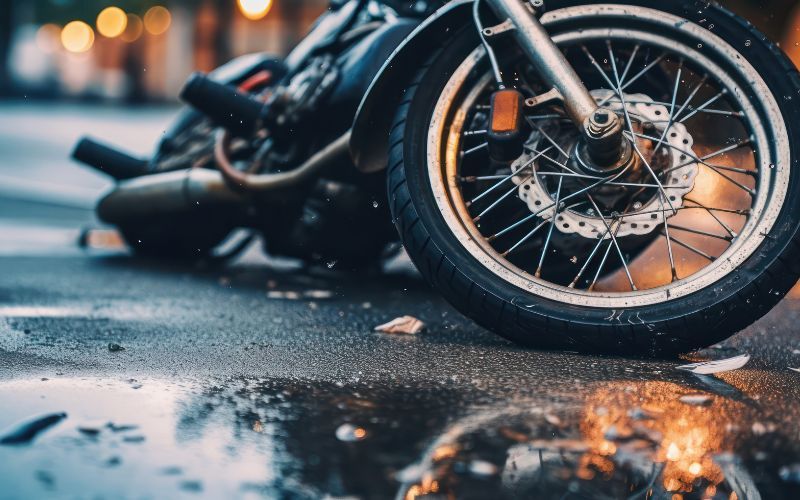
Written on September 25, 2023.
Written by James J. Kirshbaum. Posted in Motorcycle Accidents.
The aftermath of a motorcycle accident can be a horrific experience. As you deal with intense physical pain and emotional trauma, you likely also face mounting medical bills and the labyrinth of insurance claims.
The open road that once symbolized freedom now serves as a haunting reminder of vulnerability and loss. As bad as it feels now, imagine the situation worsening — skyrocketing medical costs, growing stacks of unpaid bills, and the unyielding stress of navigating the legal system alone.
If you find yourself in need of an injury lawyer to help you file a claim, the experienced Minnesota legal team at Kirshbaum Injury Law is here for you. Call our caring and compassionate injury lawyers at 952-545-2700 for a free consultation.
To learn more about common motorcycle injuries victims are likely to sustain in the aftermath of an accident, our motorcycle accident attorneys have put together this comprehensive guide.
Types of Injuries You Can Sustain From a Minnesota Motorcycle Accident
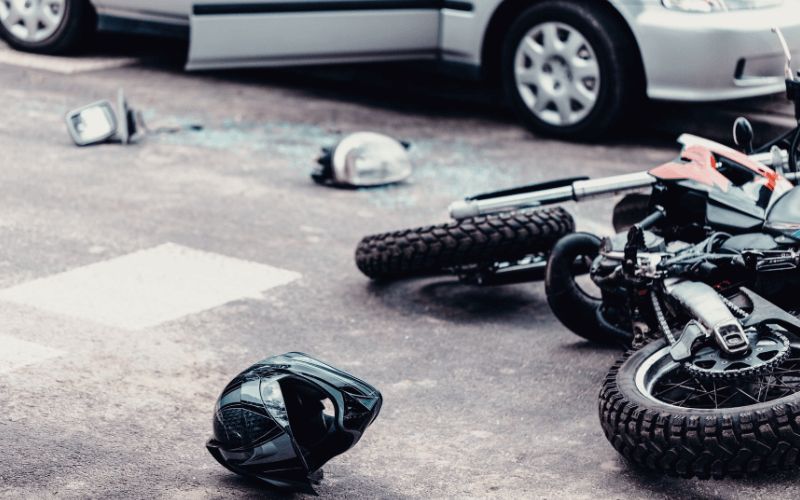
Sadly, injuries people often sustain in motorcycle accidents are horrific and life-altering. Motorcycle crash victims often suffer numerous types of injuries to the lower extremities, upper extremities, or both areas of the body. Here are some of the most common injuries people suffer after involvement in a Minnesota motorcycle collision.
Head and Neck Injuries
One of the most severe injuries Minnesota motorcycle crash victims suffer is head (including concussions) and neck injuries. Both neck and head injuries often result in permanent injury, disability, or, sadly, a victim’s death.
According to research, more than 4,500 motorcycle accident crash fatalities occur each year in the U.S. Approximately 37 percent of these deaths involve head injuries. Whiplash is another serious yet common neck injury often sustained in both motorcycle and car accidents.
Spinal Cord Injuries
Spinal cord injuries can devastate a motorcycle accident victim’s life, causing permanent disability, often resulting in partial or total paralysis. Other problems victims suffer from spinal cord injuries include incontinence, respiratory issues, and sexual dysfunction.
Road Rash
When Minnesota motorcycle accident victims come into contact with road surfaces, road rash injuries are common. A type of skin abrasion, road rashes range from mild scrapes to severe lacerations. In the most serious cases, disfigurement or deep injury requires injured persons to need tissue or skin grafts.
Broken Bones
Breaks and fractures in bones are also common motorcycle crash injuries. Parts of the body often affected include the pelvis, femur, forearm, and shins.
Lower Extremities
Injury to the body’s lower extremities is another of the most common types of wounds victims of motorcycle accident injuries suffer. These include:
- Leg injuries and fractures
- Foot injuries and fractures
- Pelvis
- Knee problems
People sustaining lower extremity injuries are often left with mobility issues and chronic pain. In the most serious of injuries, victims may need partial or full leg amputations
Upper Extremities
Injury to upper extremity areas of the body include broken ribs, head injuries, neck injuries, thorax injuries, abdominal injuries, broken arms, and broken bones or fractures in the hands. Victims commonly are left with chronic pain, limited mobility, nerve damage, and, in very serious injury cases, full or partial amputations of arms and hands.
Internal Damage
Internal injuries can be serious, even life-threatening. Common motorcycle accident injuries include collapsed lung, internal bleeding, aorta tears, bleeding surrounding the lungs, trauma/tears to organs, and hemorrhages, along with tendon, muscle, and joint injuries.
It is vital for anyone involved in a motorcycle crash to seek medical attention immediately in case there are hidden injuries, such as traumatic brain injury (TBI), internal injuries, organ damage, skull fractures, or other serious injuries caused by blunt force trauma experienced in a crash.
Which Part of the Body is Most Affected in Motorcycle Accidents?
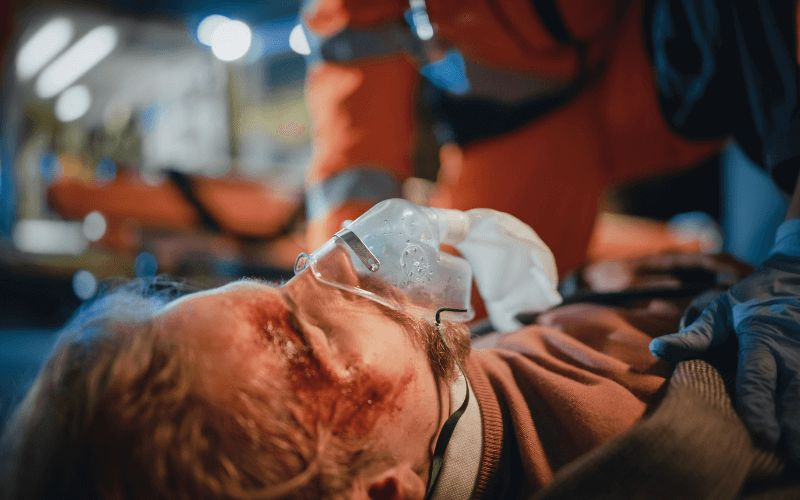
According to a study conducted on injury patterns of motorcycles, researchers found the most common type of injuries to a motorcyclist occurs on their head and facial areas. Most personal injury victims were brought in with at least two injury regions. The least affected areas were the arms, hips, and elbows.
What is the Cause of Most Minnesota Motorcycle Injuries?
Motorcycle riders often receive high criticism as being the cause of an accident, but frequently it is other motorists on the road who cause bike accidents because drivers do not see the motorcycle. Common causes of motorcycle accident injuries in Minnesota include:
Left Turns
Approximately half of all fatalities associated with motorcycle accidents are caused by cars making left-hand turns. When a car turns in front of a motorcycle on a Minnesota roadway, the results can be devastating. Oftentimes, the automobile driver lacks depth perception, neglects to check their blind spot, simply fails to yield, or does not see a motorcyclist in its path.
Impaired Driving
Driving any motor vehicle while impaired is highly dangerous and quickly can lead to a crash. If a cyclist operates their bike under the influence of alcohol or drugs, this can result in catastrophic injuries.
Lane Splitting
Lane splitting is when a motorcyclist rides between lanes in slow-moving or stopped traffic. In some states, lane splitting is legal. Minnesota is not one of them. The only exception is for police or if two motorcycle riders agree to share a lane side-by-side.
Lane Switching
Lane switching often contributes to motor vehicle accidents, but risks are higher for motorcycle riders since they are small enough to easily fit into an automobile or truck driver’s blind spot. If a car merges into a lane a motorcycle is already operating, the cyclist can suffer serious injury.
What Type of Accident is the Most Deadly to Minnesota Motorcyclists?
Any motorcycle accident can be deadly, but some more so than others. The protective elements a car has for its passengers are not present in a motorcycle’s structure. Head-on collisions are a type of crash that increases the risk of fatality as there is very little to protect the cyclist from a car. These accidents typically occur due to a driver running through red lights or stop signs.
How Can Someone Avoid a Motorcycle Injury?
Accidents are an unfortunate fact of life on our roadways, but you can take specific steps to better protect yourself from severe injuries. Being vigilant while driving is one way to help prevent injury, but wearing the necessary padding and gear when operating a motorcycle can also help avoid injuries.
Minnesota does not have a universal helmet law. Only riders under the age of 18 must wear a DOT-approved motorcycle helmet. Individuals over the age of 18 do not have to abide by any helmet use requirements when riding a bike, as the state’s universal helmet law was repealed in 1977.
However, just because wearing a helmet is not currently legally required, as a driver of any age, you should use helmets to protect yourself from a head injury. Other protective clothing you should invest in include gloves, boots, and other types of gear designed for motorcyclists.
Who is at Fault in a Minnesota Motorcycle Accident?
Sometimes a biker may be responsible for a collision with an automobile, but oftentimes drivers of larger vehicles are found to be the negligent party. Determining fault in a Minnesota motorcycle accident is important as motorcycle crashes tend to lead to more serious injuries.
Minnesota is a no-fault state for traffic accidents, which means you need to first turn to your own insurance to collect compensation if you suffer a bike injury, regardless of fault. However, carrying no-fault insurance on motorcycles is not required like it is for cars and trucks, but buying this optional coverage can be helpful in covering accident costs.
Do I Need an Attorney If I Have Been Injured in a Minnesota Motorcycle Accident?

Depending upon the extent of your injuries and damages, you may be able to sue the negligent driver for damages to help cover medical expenses and other losses associated with a motorcycle crash. Working with a motorcycle accident lawyer helps to strengthen your chances of getting the compensation you need.
A good personal injury lawyer will provide you with a free consultation, provide legal advice, and determine if you meet the four elements of a negligence claim: duty, breach, causation, and damages. Before heading to trial, they will try negotiating with the insurance company and fight in your best interest.
Have You or a Loved One Been Injured in a Motorcycle Crash?
If you or a loved one are suffering the anguish and pain associated with a motorcycle injury, the compassionate Minnesota personal injury attorneys at Kirshbaum Injury Law are here for you. We will stand by you and aggressively advocate for you with your bike injury claim.
Our injury lawyers service Minneapolis, St. Paul, and the entire state of Minnesota. To request a free consultation, call our law firm at 952-545-2700 or complete our convenient online contact form to speak with an experienced motorcycle accident attorney at Kirshbaum Injury Law today.

Written By James J. Kirshbaum
Jim is a very experienced trial lawyer having conducted jury trials in multiple states both on behalf of injured people and on behalf of defending insurance companies.
Schedule a Free Consultation with James J. Kirshbaum
Common Slip and Fall Injury Symptoms to Watch for
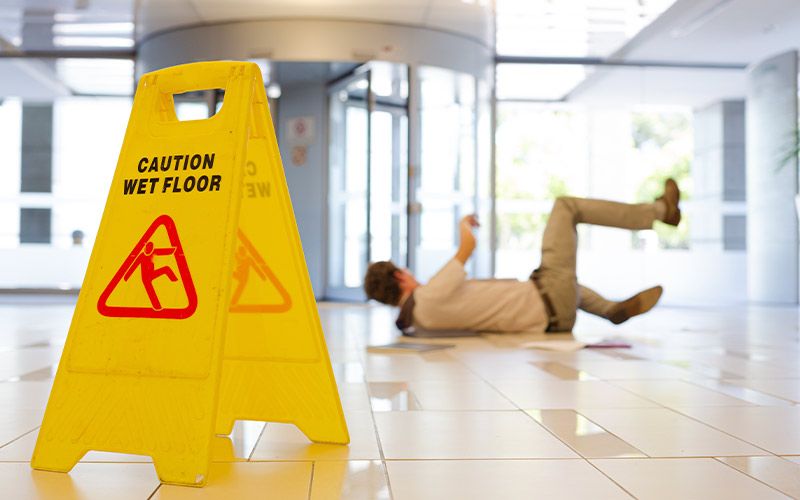
Written on April 25, 2023.
Written by James J. Kirshbaum. Posted in Premises Liability.
Immediately after a fall in or around a store, whether due to unmarked slippery floors or faulty staircases or handrails, you might brush it off, thinking it was nothing. Yet, the pain from the fall you thought was not important could turn into a more serious injury and result in unexpected medical costs. Continue reading to see what symptoms you need to be watchful for after a slip-and-fall injury and, if severe enough, why it might be time to involve one of the experienced premises liability attorneys at Kirshbaum Injury Law.
What Signs Should You Watch for After a Fall?
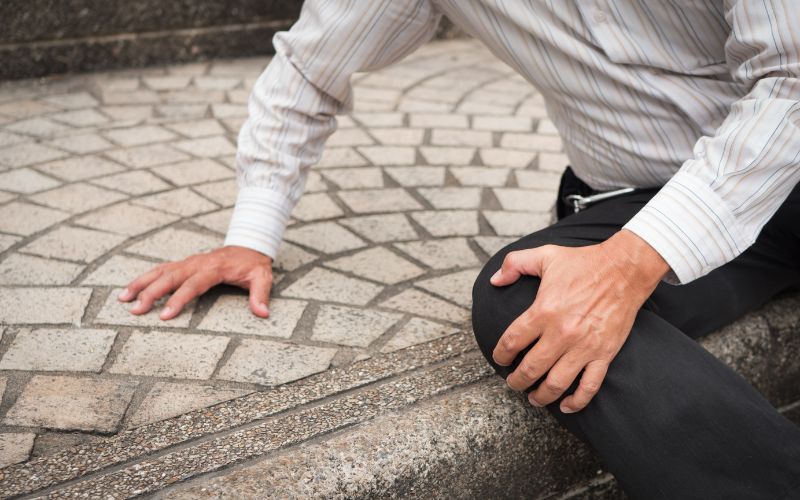
In the moments after a fall, you might not feel like you did any damage but later on it could be more severe than you thought. Here are some of the injury symptoms you should be on the watch for following any type of fall.
Continuous Pain
Continuous pain after a fall is the body’s way of signaling you that something is wrong. You may have a broken bone, neurological damage, or some other type of injury that requires medical attention.
An Immediate Sharp Pain
An immediate sharp, severe pain that does not dissipate or ease can indicate a serious injury. Look for additional symptoms in the area, such as swelling or bruising,
Your Head Hurts
Your head may hurt after a fall, especially if you hit it on the floor or on another object. Pain here can be from a minor TBI (traumatic brain injury), like a concussion, or something more severe. Accompanying the pain may be vision problems, disorientation, dizziness, ringing in your ears, and a sudden loss of balance.
Pain in your Stomach
Pain in your stomach may start slow and dull, then escalate. You may begin to feel dizzy or light-headed as the pain increases. Such pain in the abdominal area can indicate injury to your spleen, liver, or other area and also be due to internal bleeding.
Back Pain
Back pain often does not show up until hours or days after a fall and may be the result of an actual injury to the area or another condition in the body. There are a number of causes of back pain, including the strain or sprain of muscles or ligaments, damage to a spinal disc, or other internal injury.
What Should You Do if You Slip and Fall?
If you slip and fall, try not to get up too quickly. Determine if you feel any pain or other discomfort, and if not, slowly brace yourself against another person or some type of railing to rise. Again, move slowly and check your body for any symptoms that may indicate an injury.
Be sure to report the fall to the store manager or facility owner where you fell and fill out an incident report. Obtain a copy of the report if possible.
Next, ask yourself if you believe the fall was the result of someone else’s negligence. If so, do your best to collect and record details of the event, including location, hazardous conditions at the time of the slip-and-fall, and other factors, such as whether or not there were any warning signs. Take photos of the area and also of your injuries. Obtain contact information from any witnesses.
Even if you do not feel anything strongly, the first step is to seek medical help to assess and treat any potential injuries. According to reports by the CDC (Centers for Disease Control and Prevention), falls can be harmful as roughly one in five causes a serious injury, especially in older adults who are 65 and beyond.
Contact a dedicated Minnesota personal injury attorney for a consultation as soon as possible. This attorney can review the circumstances surrounding the fall, provide legal advice on your rights, and help you file a claim. They can also communicate and negotiate with insurance companies, so you can focus more on healing.
Common Injuries Sustained from a Slip and Fall
After a slip and fall, several different kinds of injuries are likely. These include the following.
Broken Bones
With over 200 bones in the body, it is no wonder that broken bones are a common injury sustained during a fall. The most common areas for broken bones include the arm, wrist, and ankle. You may need an x-ray or other diagnostic test to determine the location. Hip fractures are also possible.
Head Injuries
Head injuries result when you are unable to avoid striking your head against the floor, ground, or another object in your path. These injuries can be mild and only give you a slight headache or be severe, even causing a loss of consciousness.
Neck Injuries
An injury to the neck can occur, such as whiplash (soft tissue injury), herniation of a disc, or fracture to the cervical vertebrae.
Bruises & Sprains
Bruises are common following a fall and can appear on any part of the body. While these may seem minor, in some cases, they are signs of an internal injury. Sprains are also common, especially in the wrists if you try to catch yourself or lessen the impact of the fall with your hands.
Arm or Leg Injuries
Injuries in your extremities are also common and may appear in the form of fractures or sprains in the knee, ankle, or wrist. Specific arm injuries include damage to the shoulder joint or elbow. Leg injuries can include sprains or pulled muscles in the calf or thigh areas.
Back Injuries
Sudden impact or stress on the back can result in a number of injuries, including herniated discs, fractures, and muscle strains or sprains. In some falls, fractures to the spinal cord occur and can cause nerve damage and even paralysis.
What Usually Causes Someone to Slip and Fall?
The most common causes for someone to slip and fall include weather conditions, broken handrails, slippery surfaces, and uneven or damaged floors.
Weather Conditions
Changing weather conditions, such as rain, ice, or snow, can lead to slippery surfaces on sidewalks, parking lots, and others where people walk daily. Water can pool in holes or uneven walkways and be invisible. If ice builds up on a property, such as on a ramp leading into a store or covering a parking lot, it can also be the cause of a slip and fall.
Broken Handrails
Handrails are meant to be a safety feature for people, and when they are broken or start to become unattached, they are fall risk factors. Grasping or placing weight on these can cause you to slip and fall without warning.
Slippery Surfaces
A slip and fall in a store can be the result of damp or wet floors, creating a slippery surface. This situation usually occurs due to a recent mopping in the area by an employee or a leak in the roof.
Uneven or Damaged Floors
Uneven or damaged floors can cause you to slip or trip, resulting in a fall that can cause various injuries. Flooring may be loose, carpeting or rugs unattached, or floors uneven.
Why Should You See a Doctor After a Slip and Fall?
While you may not initially feel that injury occurred during a slip and fall, be proactive and seek a medical exam to be sure. It is important to see a doctor following a fall for several reasons, including the following:
- To determine the seriousness of any injury which is already showing symptoms
- To identify unknown injuries
- To prevent additional injury, as you might now have a higher fall risk and require medical advice regarding fall prevention
If you are an older adult, there may be severe injuries or underlying medical conditions (e.g., low blood pressure) contributing to the fall.
When Should You Contact a Minnesota Slip-and-Fall Attorney?
After a slip and fall accident due to another party’s negligence, your first concern is seeking medical care. Not only is this essential to your well-being, but any delay in seeking that healthcare treatment can reduce the strength of your case. Once you receive initial evaluation, diagnosis, and medical treatment at an emergency room or your own doctor’s office, next consider consulting with an attorney.
By attending to your health first, the types of injuries you sustain and the treatments you need will be well documented. This documentation by a medical professional will play a key role in your case, serving as valuable evidence. Your attorney will compile this information along with a calculation of damages to seek, including medical bills and expenses (past and future), any lost wages, and others, depending on your particular circumstances.
The earlier you discuss your case with legal counsel, the stronger your chance of filing a successful claim for the full amount of compensation you deserve. Also, in the state of Minnesota, in most slip and fall cases, you have six years from the injury date to file your personal injury claim. Even if you didn’t file early on, you still have time to seek legal advice and file it within that timeframe.
Premises Liability in Slip and Fall Cases

If your slip and fall occurs on the property of another, you may be able to file a premises liability lawsuit to obtain enough compensation to meet your needs. Premises liability law in Minnesota holds that a property owner is responsible for maintaining their premises in a safe and secure manner. If they neglect to do so, that owner or even the manager of the business at that location can be held liable for your injuries.
In order to file a successful lawsuit, your premises liability attorney will need to prove the following four elements showing negligence on behalf of the property owner.
- A condition on the premises was hazardous and existed at the time of your fall.
- The hazardous condition was obvious enough that the property owner knew about it or should have known of its existence.
- The owner did not correct the known dangerous condition.
- You sustained an injury as a direct result of that condition.
Your attorney will work diligently to prove these four elements by compiling evidence and speaking to witnesses. You can expect the property owner or manager and their insurance companies to fight against these accusations, often blaming you for the fall and resulting injury. With tenacious legal advice and representation, however, you can win your lawsuit and obtain the compensation you deserve.
Have You Noticed an Unusual Pain Recently?
Pains can start out gradually or affect you all at once. If that pain follows a slip and fall that resulted from the negligence of another, such as a store owner, seek medical attention for you or a loved one first, then contact the professionals at Kirshbaum Injury Law. Our premises liability lawyers are available for free consultations, during which you can find out what your options are and the next steps to take. Call our phone number at 952-545-2700 or use our convenient online form to get in touch. We are here to serve clients in the Minneapolis/St. Paul area, as well as the entire state of Minnesota.

Written By James J. Kirshbaum
Jim is a very experienced trial lawyer having conducted jury trials in multiple states both on behalf of injured people and on behalf of defending insurance companies.
Schedule a Free Consultation with James J. Kirshbaum
Can I Sue a Property Owner for Falls on Ice?
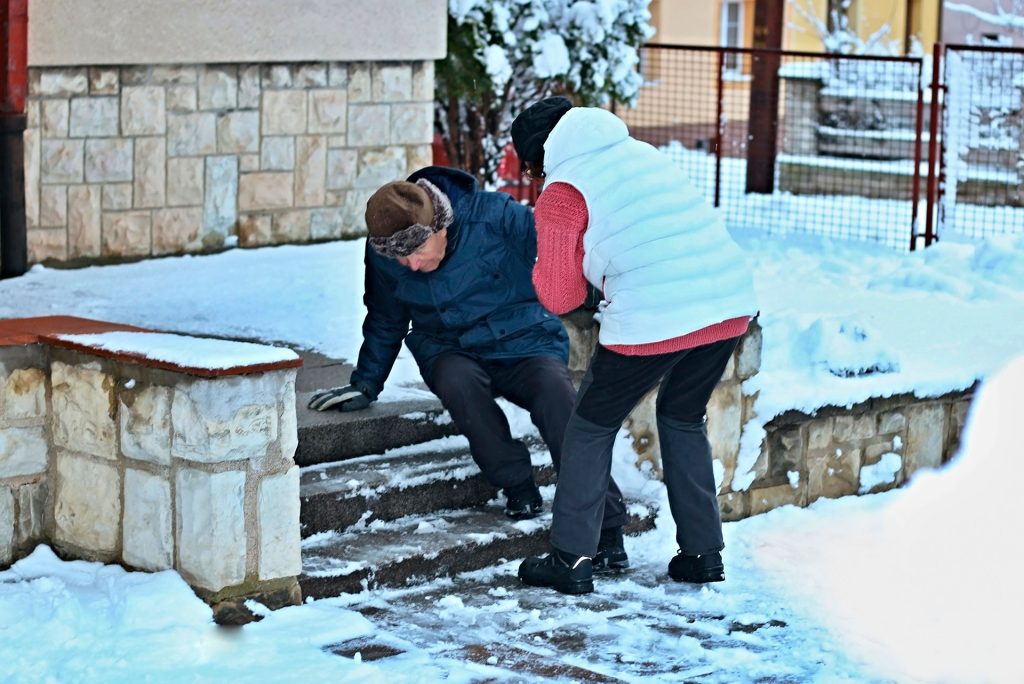
Written on January 10, 2023.
Written by James J. Kirshbaum. Posted in Premises Liability.
In Minnesota, slip and fall accidents often involves negligence, but how do the winter season and the accumulation of snow and ice affect premises liability? Slip and falls often happen in parking lots and walkways outside businesses, and the risk of slipping certainly increases in the winter. Depending on the situation, the property owner or manager can be held liable for your serious injuries.
Did you suffer a slip and fall injury while out shopping? Do you suspect you have a claim and wonder who can be held liable for your injuries? Contact the experienced attorneys at Kirshbaum Injury Law at 952-545-2700.
What to Do When You Slip and Fall on Ice
If you slip and fall on ice on someone else’s property, the first thing to do is seek medical attention. After a doctor assesses your injuries, you should file an incident report with the property owner. Finally, and perhaps most importantly, always contact an experienced Minnesota personal injury lawyer.
Seek Medical Attention
Even if you do not think your injury is serious, always seek medical attention when you slip and fall. Many injuries can take weeks or even months before they show symptoms, and seeking immediate medical treatment can help prevent an injury from worsening. When the time comes to pursue a personal injury case, early medical attention demonstrates you took things seriously from the start.
File an Incident Report
Accident reports are essential to your personal injury claim. Be sure that the property manager or owner takes detailed notes about the accident, how it happened, what happened, and when and where it occurred. Your accident report will be important while your personal injury attorney handles your case. If you can, take photos of the scene yourself and get contact information from witnesses willing to testify to the incident.
Contact an Attorney
The insurance company will go to great lengths to avoid paying out huge claims. Always remember that they are for-profit companies, and they do not make money by paying out money. Even if they seem compassionate at first, they are not your friend, and their only goal is to get you to sign away your right to greater compensation. When you contact a law firm with experienced slip and fall attorneys, they can help you stand up to the adjusters and fight for the compensation you deserve.
You have legal rights if you have suffered serious injuries from slip and fall accidents on someone else’s property. You deserve compensation for medical expenses, pain and suffering, lost wages, and other damages. Contact a personal injury attorney at Kirshbaum Injury Law for legal advice and a free consultation today. Call 952-545-2700 or fill out our online contact form to speak with one of our attorneys.
Injuries From Slip and Fall on Ice or Snow
Some of the most common injuries from a slip and fall on an accumulation of ice, black ice, or excessive accumulation of snow include bruises, cuts, sprains, and the like. More serious injuries include back and neck injuries, broken bones, and traumatic brain injuries from the victim hitting their head. These types of injuries from icy conditions and winter weather conditions may make you eligible for slip and fall cases to recover damages.
Back Injuries
When you fall on concrete after a slip in icy conditions, you may twist awkwardly or even suffer a severe blunt force impact that can damage your spine. Additionally, you may suffer serious muscle, tendon, or ligament injuries that can take months or even years to heal. Back injuries are extremely serious. They can result in loss of motion, chronic pain, and even paralysis and death.
Broken Bones
Broken bones can take anywhere from six weeks to months to heal. In compound fractures, the broken bone coincides with tears in your ligaments, muscles, and tendons. These can take months or even years to heal, and many people who suffer compound fractures are never the same again. If you have suffered a broken bone, you could be eligible for significant compensation for your injury.
Traumatic Brain Injuries
Traumatic brain injuries can result in a wide range of what are colloquially called invisible injuries. Traumatic brain injuries, or TBIs, can cause emotional trauma, mood swings, personality changes, memory issues, and the like. TBIs can also cause many physical conditions like paralysis, loss of range of motion, weakness, chronic pain, and many other health conditions.
What is the Statute of Limitations for Slip and Fall Cases in Minnesota?
The statute of limitations is the time frame you have to file a lawsuit. Every state has its own statute of limitations, which can vary based on the circumstances of the lawsuit. Minnesota has a very long time frame to file slip and fall cases or other types of personal injury cases. Here, you have six years from the accident date to file a lawsuit. In a wrongful death case, where you lose a loved one to such an injury, you can file your lawsuit up to six years from the date of death.
However, just because you have six years does not mean you should wait for six years. Often, the sooner you file your injury case, the better off you are. Waiting to file also means that evidence is aging. You could lose access to evidence like security footage that will back up your story if you wait too long.
What is Reasonable Care for Minnesota Premises Liability Cases?
Property owners and property managers have a duty of care toward visitors on their property. At the same time, visitors to the property have a reasonable expectation of safety. Reasonable care means they must show the same degree of concern for safety that any rational and reasonable person would show under similar circumstances. This is also sometimes referred to as the reasonable person standard.
Suppose an area experiences severe winter weather that leaves a greater-than-natural accumulation of snow or ice. Property owners must attempt to address those risks under this reasonable expectation and duty of care. They should, within 24 hours of the winter ice or snowstorm, make snow removal efforts and take measures to mitigate the ice. These efforts may include shoveling walkways, putting snow melt or rock salt down on parking lots or driveways, and other efforts to remove potentially dangerous conditions.
What is Considered a Natural Accumulation of Snow in Minnesota?
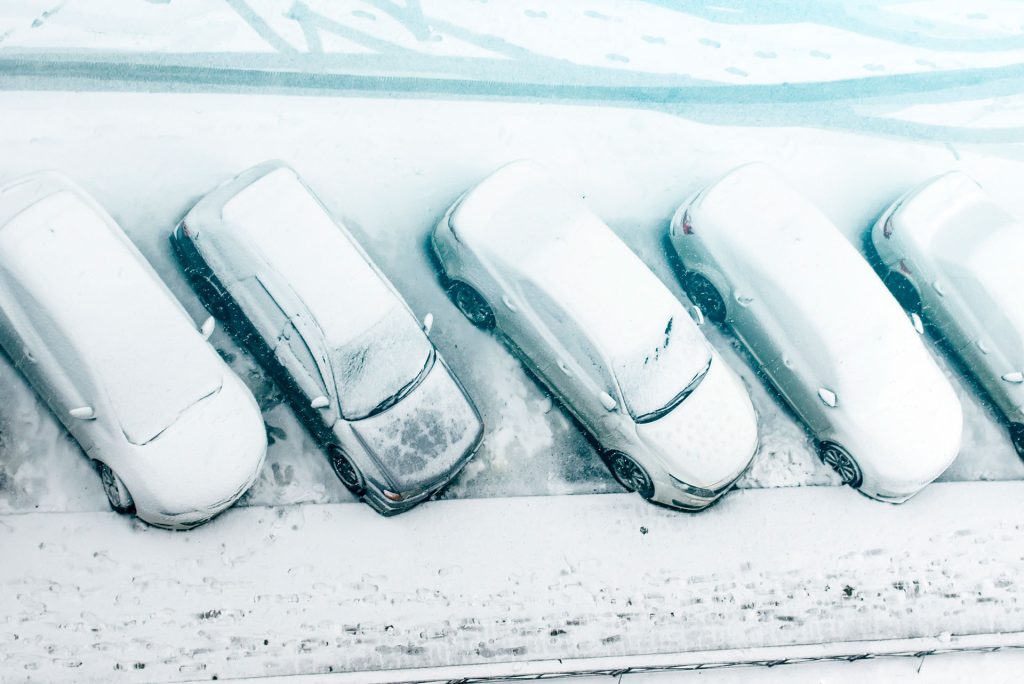
A natural accumulation of snow is an amount that might move liability off a property owner. The exact amount of snow considered natural is subjective and can vary based on the conditions after a given weather event. As snow and ice accumulate during a weather event, the property owner may need more time to remove it properly. If this is the case, the property owner may cite natural accumulation as a defense.
If the property manager or owner cites natural accumulation, this does not mean you cannot get compensated for your injury. It just makes it more complex for your personal injury lawyer to build a case. The average amount of annual snowfall varies widely in Minnesota. In the southwest, it sits at around 36 inches. In the snow belt along Lake Superior, it can be as high as 70 inches or more. In the end, natural accumulation refers more to the time frame and when the snow falls than the specific amount of snow.
In the end, the property owner must be given a reasonable amount of time for snow and ice removal. If they do not have enough time to do so, they may cite this as a defense against your personal injury claim.
What Factors Will a Court Evaluate During a Minnesota Premises Liability Case?
A court will consider several factors during a slip and fall case in Minnesota. Premises liability cases are types of personal injury cases. The core of any personal injury case, be it a slip and fall, a car accident, or any other injury where you seek damages, is negligence. Negligence is a legal term that requires several provable factors.
The first of these is that the defendant (property owners, property managers, or even homeowners) had a duty of care to provide a reasonable expectation of safety for visitors. The second is that the defendant violated this duty of care, and this violation led directly or proximately to the accident. Finally, it must be provable that your injuries were the result of the accident.
In a slip and fall case, the courts will first consider whether or not the property owner should have known the danger. Next, they will review whether the property owner had enough time to address the danger. Third, the judge will consider whether the defendant took action to prevent or address the risk. They will also address whether the actions taken were sufficient and whether the defendant had the means to take reasonable means to address the risk.
As mentioned above, if you slip and fall in a parking lot while a snowstorm is in progress, the courts may rule that the defendant did not have the time or means to reasonably address the danger because the weather event was still happening. If, on the other hand, the storm occurred two days ago and the parking lot was still covered with snow and ice, despite the property owner having the means to clear it, you may have a strong case for damages.
How Much is My Slip and Fall Case Worth?

It is impossible to say what your case may be worth without learning its details. These cases are unique, and each takes its own path. You may, however, be eligible to receive similar types of damages to other personal injury cases. These include your medical costs, lost wages, pain and suffering, and others.
Damages in a personal injury case are broadly divided into two categories: special damages (also called or economic damages) and general damages (also called non-economic damages).
Special or Economic Damages
Special damages or economic damages cover those things that are easy to value. This includes all of your medical bills, including doctor’s office visits, medication, therapy, procedures, transportation, and any necessary home care costs. It also consists of your lost wages, including those you have already lost, wages you may have earned in the future, and possibly even loss of retirement benefits, depending on the severity of the injury. In the case of a wrongful death suit, these damages can also include reasonable funeral and burial costs.
General or Non-Economic Damages
Non-economic damages or general damages are more subjective. They are also referred to as pain and suffering. These include invisible injuries like the loss of consortium, loss of comfort and companionship, loss of ability to enjoy life, emotional trauma, PTSD, and other things that are trickier to value. They also form the core of negotiations in many cases, as the insurance company will value them differently than you and your attorney and will often try to downplay them.
Do You Have a Slip and Fall Case in Minnesota This Winter?
If you have suffered a serious injury from a fall in a parking lot, on stairs, on a walkway, or anywhere on someone else’s property, whether commercial or private, you may be eligible for significant compensation. Getting compensated, however, can be complicated, and it is important to have an experienced Minnesota personal injury lawyer in your corner who is knowledgeable about premises liability cases.
At Kirshbaum Injury Law, we bring decades of combined experience to the table and have represented many people like you from all over Minnesota. We deeply value our open and honest attorney-client relationship and strive to be a compassionate and tenacious ally to everyone who enters our doors. We focus on fair outcomes, not exceptions and disclaimers, and we have a track record of satisfied clients. Our law firm is also highly accessible, offering virtual consultations and legal advice to all our potential and current clients.
Was Your Minnesota Slip and Fall on Ice Unavoidable?
If you fell and were severely hurt on another person’s property in Minnesota, you do not have to go it alone. Let our legal team take on the fight with the insurance company to seek compensation so you can focus on the all-important task of getting well again. Get in touch with us today at 952-545-2700 or through our online form to schedule your free consultation.

Written By James J. Kirshbaum
Jim is a very experienced trial lawyer having conducted jury trials in multiple states both on behalf of injured people and on behalf of defending insurance companies.
Schedule a Free Consultation with James J. Kirshbaum

Written on December 8, 2022.
Written by James J. Kirshbaum. Posted in Car Accidents.
In 2019, 80,636 car accidents were reported in Minnesota, with 27,260 people being seriously injured in some way as a direct result of the accident. Injuries from car accidents are expensive, especially when you do not have the proper car insurance coverage. Some states offer no-fault benefits where your own insurance company covers part of the damages, but others require the at-fault driver’s insurance to pay for medical bills, wage loss, and pain and suffering.
It is vital to understand the protection available in Minnesota and what it means as you prepare for emergencies. Accidents happen to good people every day and can cause long-term or permanent injury, permanent disfigurement, or disability, changing your life instantly. It is horrible when it happens, but the compassionate attorneys at Kirshbaum Injury Law are here to help people just like you. If you have been in an accident in Minnesota, we will fight for your rights. Schedule a virtual consultation today from the comfort of your own home.
What is the Difference Between No-Fault and At-Fault Coverage?
A no-fault state does not necessarily mean that nobody is at fault for an accident. It means that your car insurance company pays for your medical bills and lost wages, assuming you have personal injury protection (PIP coverage), also called no-fault insurance. In an at-fault state, the at-fault party’s bodily injury car insurance coverage pays for the medical expenses and non-medical expenses of the auto accident.
Even in no-fault states, however, your PIP coverage does not necessarily cover all losses in your accident. As stated above, PIP stands for personal injury protection, and it only covers certain aspects of the injury, such as your medical bills and a portion of your lost wages.
Is Minnesota a No-Fault State?
Eleven states have no-fault laws for auto accidents. Minnesota is one of these no-fault system states. If you have questions about seeking loss benefits under Minnesota’s no-fault law or holding the other driver responsible, Kirshbaum Injury Law can help. Get in touch with us at 952-545-2700 or use our online contact form for a free consultation about your case today.
How Does the No-Fault Insurance System Work in Minnesota?
According to state laws, all in-state drivers must carry Minnesota no-fault insurance. This personal injury protection insurance policy is supposed to cover certain losses, such as your medical treatment and bills after any motor vehicle accident. It does not matter who was at fault for the accident; you file a no-fault insurance claim for your injury related medical bills to be paid by your own insurance company under Minnesota law.
What is Personal Injury Protection (PIP)?
Personal injury protection is a type of insurance coverage you carry on your auto insurance policy. It is a part of minimum coverage requirements under Minnesota law, so all drivers in the state of Minnesota should have it. It is designed to ensure that your medical bills are covered after a car crash, regardless of who is at fault in an accident.
What Does PIP Cover?
Personal injury protection, or PIP coverage, pays for certain expenses of any covered person up to the policy limits. These expenses include all of your medical treatment and medical bills related to the accident, your income loss from being unable to work due to the accident, and your costs of replacement services, such as the need for in-home care and housekeeping. Finally, in the case of death from a car accident, PIP coverage will cover up to $2,000 in funeral expenses.
Is There a Minimum Amount of PIP Coverage in Minnesota?
Yes, the minimum PIP coverage in Minnesota is $40,000 per person per accident. You can use $20,000 to cover medical bills and the remaining $20,000 for non-medical expenses. Drivers may, however, purchase coverage above this minimum level.
Who Does No-Fault Insurance Cover?
No-fault insurance covers a range of people; you do not have to purchase additional coverage for everyone who drives your car. PIP coverage will cover you as the policyholder, your spouse and children, relatives who live in your house who do not have their own insurance policy, and anyone using your car with your permission who also does not have their own coverage. Even if more than one person is in the car, PIP insurance will cover them so long as they meet the requirements.
Can I Use PIP for Slip and Fall or Product Injury Accidents?
No, you cannot seek personal injury protection benefits if you slip and fall in a parking lot or get injured in any other way besides a car accident. PIP is expressly a part of your car insurance policy and only applies in car accidents. If, however, you are a pedestrian who gets struck by a car in Minnesota, you can recover some of your damages through your personal injury protection or PIP coverage.
Is There a Deadline for No-Fault Claims in Minnesota?
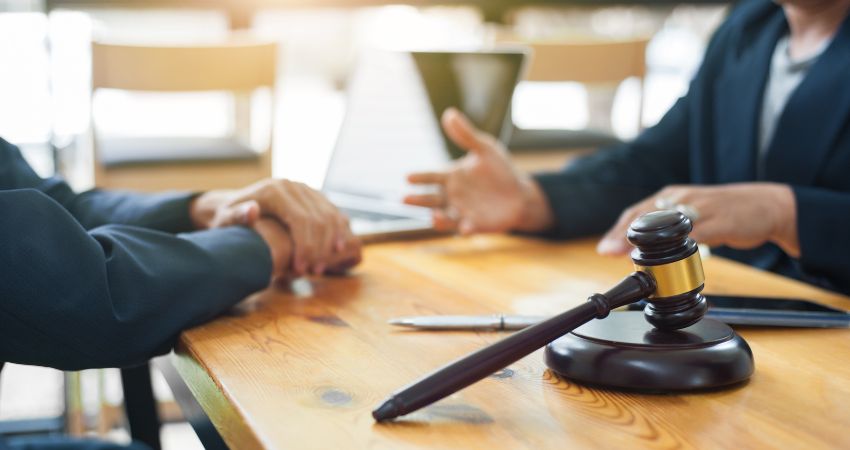
Yes, and filing a no-fault claim is much different than a personal injury lawsuit. No-fault claims must be filed within six months of the car accident. You must provide proof of the expenses and complete an application. You must also submit to any medical examination requested. According to the Minnesota Department of Commerce, you should submit any bills to your insurance company as you receive them.
Are There Any Other Coverage Requirements in Minnesota?
Yes, Minnesota state law requires several other types of insurance coverage for all drivers. Besides personal injury protection coverage, you must also carry liability coverage, uninsured motorist coverage, and underinsured motorist coverage. Each of these provides essential protection should you get into an accident.
Technically, if another driver causes you serious injury and is found to be at fault for the accident, they are responsible for paying damages that exceed your PIP coverage. This is where their liability coverage comes into play. If they do not have insurance coverage, you may have difficulty collecting the damages they owe you. While the other driver is still technically required to pay you, they cannot pay what they do not have.
This is why uninsured and underinsured motorist coverage is necessary. These forms of insurance are important additional protections intended to make sure your injuries are covered.
Liability Coverage
Liability insurance means the insurance company will cover expenses if you are in an accident that you cause. It is designed to protect you when the other driver needs additional medical care and for their recovery of lost wages, pain and suffering, and other damages from a car accident where you are at fault. Minimum liability coverage in Minnesota is called 30/60/10 coverage; it requires $30,000 for bodily injury per person, $60,000 for bodily injury per accident, and $10,000 for property damage per accident.
Uninsured Motorist Coverage
Even though it is illegal to drive without car insurance in Minnesota, some people sadly do so. Suppose you are in an accident with a driver who does not have coverage. In that case, uninsured motorist protection allows you to recover your losses (over and above PIP benefits) through your own insurance company. In Minnesota, the minimum coverage for uninsured motorists, also called UM coverage, is $25,000 for injuries to one person or $50,000 for injuries to two or more people.
Underinsured Motorist Coverage
Similar to uninsured coverage, underinsured motorist coverage protects you if you are in an accident with a driver who does not have enough insurance to cover your damages. For example, if you are in an accident with someone with only the minimum liability coverage, but your injuries exceed their $30,000 policy limit, your underinsured motorist policy may cover the remaining balance.
In Minnesota, underinsured motorist coverage (or UIM) minimums are $25,000 for injuries to one person or $50,000 for injuries to two or more people, over and above PIP benefits and liability coverage for the other driver.
Can I Buy More Insurance?
Yes, you can always buy more insurance coverage than the minimum required, and it may be a good idea if you can afford it. However, buying more insurance results in higher premiums. This is why so many people drive with the state minimum allowable insurance: to save money on their monthly bills.
Can You File a Car Accident Lawsuit in a No-Fault State?
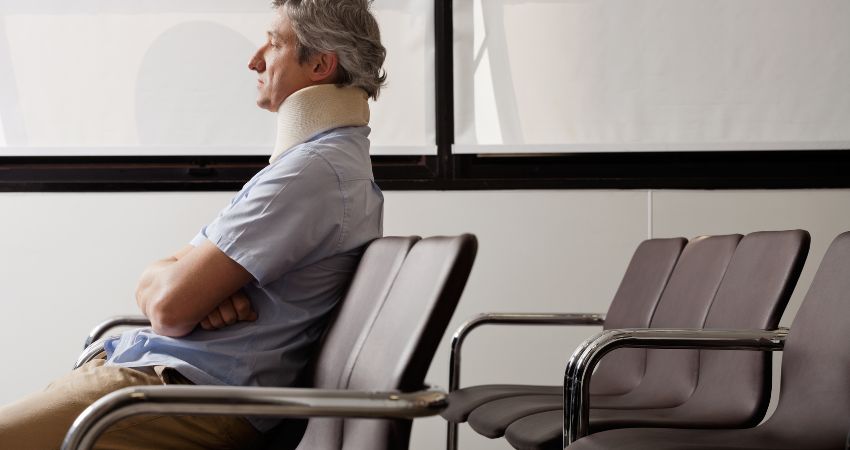
A no-fault claim does not cover what is commonly known as pain and suffering to an injured party. Pain and suffering covers all of the non-economic damages an injured person might face, such as depression, PTSD, loss of consortium, loss of enjoyment of life, and other invisible injuries. You need to file a personal injury claim to receive payment for pain and suffering. Likewise, the no-fault car insurance system does not cover property damage to your vehicle.
To pursue a claim in Minnesota, your injuries must meet certain specific requirements. The “thresholds” for commencing a liability claim are 1. Medical expenses exceeding $4,000 (not including diagnostic tests like X-rays or MRI scans); 2. at least 60 days of disability; 3. Scarring or disfigurement; or 4. permanent injury from the accident. Even if you meet these thresholds, you can only sue for any damages your PIP does not cover.
Suppose you file a lawsuit in Minnesota. In that case, you can seek damages for pain and suffering, medical bills, lost wages, property damage, and other losses you face. A personal injury lawyer at Kirshbaum Injury Law can help you file a lawsuit if you decide to go that route.
What is the Statute of Limitations for Filing a Lawsuit in Minnesota?
In the state of Minnesota, you have a six-year statute of limitations to file a lawsuit. This means you must file your case within six years of the accident. If your case involved fatalities, you have three years after the death and six years from the date of the accident to file.
Why Should I Hire a Minnesota Car Accident Attorney?
Filing for PIP benefits and filing against the other driver’s insurance if your injuries exceed those limits seems straightforward.
However, these cases almost always get complicated. Insurance companies are for-profit businesses. They do not make money by paying out large claims. Often, the insurance adjuster will seem very compassionate when they first meet you, but then they will try to get you to sign off on a very low offer. When you ask for more, they will bully you, cajole you, strong-arm you, and even threaten you with no settlement whatsoever if you do not agree.
When dealing with your insurance company, having a car accident lawyer in your corner can help keep them honest. Your attorney can take over communications and will know how to fight back when the insurance company delays or tries to get out of paying your claim.
When filing a personal injury suit against the other driver, the insurance company will most certainly try to avoid paying. They will also have attorneys on their side who know how to use the law against you. Minnesota, for example, uses a doctrine known as modified comparative fault in personal injury cases.
This doctrine states that your award in a personal injury lawsuit will be reduced by whatever percentage of fault you hold. Further, if you hold more than 50% fault, you are barred from recovering any damages. This means that the other driver’s insurance company will try to blame you for the accident.
Your car accident attorney knows how to fight back, prove that the other driver caused the accident, and hold the at-fault driver responsible. They will improve your chances of getting a significant settlement for your long-term or permanent injury, permanent disfigurement, or disability.
Hold At-Fault Drivers Accountable With Kirshbaum Injury Law
When your injuries and property damage exceed your no-fault coverage limits, you still have the right to seek compensation for your injuries. The experienced and compassionate personal injury lawyers at Kirshbaum Injury Law can help you hold at-fault drivers accountable and determine the true cost of your injuries while helping you navigate Minnesota’s at-fault insurance laws.
We have over 80 years of combined experience dealing with personal injury and car accident cases. We know how difficult this time is for you and your family, and we want to be the caring and compassionate yet dogged ally fighting in your corner for the compensation you deserve. You have a story to tell, and we are ready to listen and battle for compensation to cover lost wages, pain and suffering, and medical bills.
You do not have to take our word for it. Read testimonials from satisfied clients before contacting us. When you are ready, call us at 952-545-2700 or use our online contact form to schedule your free consultation with a dedicated client concierge today.

Written By James J. Kirshbaum
Jim is a very experienced trial lawyer having conducted jury trials in multiple states both on behalf of injured people and on behalf of defending insurance companies.
Schedule a Free Consultation with James J. Kirshbaum
How Long Do Insurance Adjusters Have To Respond?

Written on October 25, 2022.
Written by James J. Kirshbaum. Posted in Car Accidents, Motorcycle Accidents.
Insurance companies are businesses that strive to run efficiently, but it is often more profitable for them to take their time with your personal injury claim rather than jump the gun and pay out a greater sum than they otherwise would. Because of this, it can take some time for the typical insurance adjuster to respond to your auto accident claim.
How long does an auto insurance adjuster have to respond? Particularly complex cases can take quite a while, with more unique and difficult cases taking up to 200 days to finally settle. That can be a seriously long time to wait when you are trying to recover from a personal injury, no matter who is at fault.
Fortunately, insurance adjusters do not have an infinite amount of time to get back to you with a settlement if you live in the state of Minnesota. In fact, there are regulations for quite a few steps of the claims process with specific time limits for each. The Kirshbaum Injury Law firm is happy to help you get a prompt response from your insurance adjuster. Contact us today for a free consultation.
How Long Do Insurance Adjusters Have to Respond to a Claim in Minnesota?
By law, insurance companies in Minnesota have to respond to an insurance claim within a specific time frame. They have 10 days to acknowledge the claim, 30 days to make a decision on the claim, and 60 days to make a payment to the claimant. This applies to homeowner policies as well, but they often receive payments a bit faster even though the deadlines are still the same.
It is important to remember that some of the deadlines are in terms of business days and therefore do not include weekends or holidays. Your insurer must complete the investigation of your claim and notify you of its acceptance or denial within 30 business days. Insurers can get more time to investigate injuries or property damage, but they must notify you within 30 business days of the extended time and provide detailed reasons why the investigation is being prolonged.
What Happens If My Insurance Fails to Meet Deadlines Set By Minnesota?
Consequences are in place for car insurance companies that fail to reach settlements within the proper time frames, but they can be difficult to enforce. The process is overseen by the Minnesota Commerce Department, and they can impose penalties on any insurer that takes too long or operates in bad faith. Insurers must also operate fairly and in good faith in accordance with state statutes.
If the insurance claims adjuster is taking too long with your claim, you may have to take action to speed up the process. This involves writing a demand letter, which is a letter formally demanding that the insurer take action on behalf of the case to avoid having penalties pursued against them in accordance with the law.
What Is a Demand Letter?
A demand letter is a detailed letter intended to compel the insurer to take action on a particular case that they are delaying. Typically, lawyers write these letters on behalf of clients. Think of it as the first step of the negotiation process in which any kind of dispute gets resolved. Remember, an insurance claim is a dispute between you and your own insurance company. You want to get as much compensation as possible, but your insurer only profits by denying you as much money as they feel they can get away with despite the premiums you pay.
The details of a demand letter should make the recipient fully understand the risks and rewards of the dispute in such a way that incites them to speed up the response. With an insurance company, for example, a demand letter would detail how beneficial it would be for them to resolve the matter quickly, while also noting the potential damages they may endure if they fail to act promptly.
One of the most important aspects of a demand letter is the clear statement of intention for what will happen if the recipient does not act quickly. A good demand letter usually threatens a lawsuit if the demands are not met. This is why demand letters tend to be particularly effective compared to other strategies, such as calling the insurance company daily.
What Happens After I Send My Demand Letter in Minnesota?
After you send a demand letter, it is time to wait for a follow-up. This wait could be as brief as a few days or as long as a few months, depending on the details of your case. However long it takes, though, it will result in one of five different outcomes.
Silence
One potential outcome is silence, in which the recipient simply ignores your demand letter. This is uncommon but does happen, and it functions similarly to another potential outcome that you may encounter in which your claim is denied.
Denial
The denial response is one in which the insurance company outright denies your claim, asserting that your insurance policy does not cover your accident or that the claim goes beyond your policy’s deductible. A denial may also include a statement regarding liability in an attempt to alleviate the insurer from insurance coverage.
Offer
If your demand letter elicits a settlement offer, then negotiations have begun. This is a fairly good step forward in most cases, and it all begins with an offer. While you can accept the offer at this stage, you are free to put forward a counteroffer and go back and forth until you reach a settlement. Your lawyer can help with the negotiation process.
Request for Evidence
Insurers can request evidence from you that demonstrates the validity of your claim to supplement your demand letter. Evidence may include such items as the police report or your medical bills regarding injuries. Some insurers may even ask for an independent medical examination.
Remember, it is important not to let any insurer take evidence away from you. Always talk to your personal injury lawyer about what you should share before handing over any valuable piece of evidence to the insurance company.
Acceptance
The rarest response to a demand letter is acceptance. This is the response in which the insurer simply agrees to your demands and settles the case with a payout. Keep in mind that this is not very likely to happen, and it will almost certainly not occur unless you draft your demand letter with the help of a car accident attorney.
How Long Should I Wait for Response From My Insurance in Minnesota?
The length of time you wait for a response from your insurance company should be less than the statute of limitations for civil lawsuits in Minnesota for car accident injuries. According to state law, this time limit is six years from the date of the accident itself. Do not wait any longer for a response to your car insurance claim than the time limit you have to file a civil suit.
When Should I Hire a Minnesota Auto Accident Attorney?
While you can handle insurance claims by yourself, it is always best to have an injury attorney by your side throughout the process. Whether the insurance company fails to respond to your claim or gives you an ungenerous offer, a lawyer can help you pursue compensation for the full extent of your injuries.
Remember, the insurance company is breaking the law if they do not respond to your claim promptly, and you have the right to file a civil suit against them if this happens. Whether you are looking to pursue a lawsuit or just want help in the negotiating process, an auto accident attorney is an integral tool to have by your side.
Streamline Your Settlement With Kirshbaum
At Kirshbaum Injury Law, our team is waiting to help you put your accident behind you and move forward. Whether you need help with negotiation, drafting a demand letter, or filing a civil suit, our team will provide professional service throughout the entire process. We are a completely virtual law firm, making it easy for you to get in touch and communicate no matter where you are. Reach out today with a phone call to 952-545-2700 or by completing our online contact form to get started.

Written By James J. Kirshbaum
Jim is a very experienced trial lawyer having conducted jury trials in multiple states both on behalf of injured people and on behalf of defending insurance companies.
Schedule a Free Consultation with James J. Kirshbaum
Do I Have To Wear a Motorcycle Helmet in Minnesota?
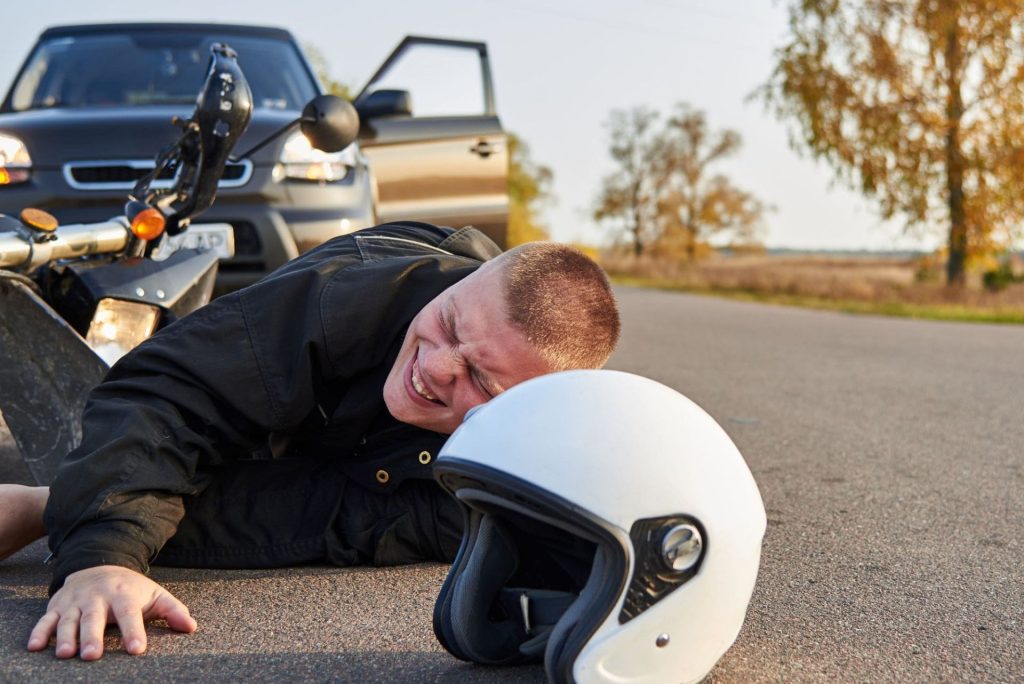
Written on September 27, 2022.
Written by James J. Kirshbaum. Posted in Motorcycle Accidents.
Motorcycle crashes can have devastating consequences, leading to a lifetime of disability or even loss of life. Whether another driver strikes you after running a red light or a collision sends you over the handlebars, motorcycles do not protect their riders, unlike other vehicles with walls and a roof. To be sure you are safe, you must follow all Minnesota statutes, including motorcycle helmet laws.
Many motorcycle riders wonder what their rights are if they are in a crash and not wearing a helmet. Kirshbaum Injury Law can help you understand the current Minnesota laws and how they impact your motorcycle accident claim. Reach out to us and let us provide the legal advice and representation you need today.
How Does Helmet Wearing Impact Motorcycle Crashes?
In 2019 alone, Minnesota motor vehicle crash statistics show that most fatal accidents involving motorcyclists occurred when the rider was not wearing a helmet. These accidents occurred in 30 out of the 44 fatal accidents that year. The use of protective headgear also reduces the risk of serious injury. In short, wearing a helmet saves lives when motorcycle accidents occur and gives you a much better chance of walking away from the collision.
Are There Minnesota Helmet Laws?
There is a Minnesota motorcycle helmet law, though it is limited. In fact, 47 of the 50 states have these laws: from Michigan to North Dakota, South Dakota to Colorado, California, Pennsylvania, and beyond. The only states that do not have helmet laws requiring some level of protective headgear for motorcycle operators and passengers are Illinois, Iowa, and New Hampshire.
However, every state’s department of transportation has a different approach to the requirement for an approved helmet. In Minnesota, only riders under 18 must wear a DOT-approved helmet. Riders with a motorcycle driver’s license or a license with a motorcycle endorsement who are over 18 years old are not required to wear a department of transportation approved helmet.
If the rider uses an instruction permit and does not have their full license, they must wear a helmet, even if they are over 18. Drivers over 18 operating a motorcycle with a full driver’s license are still required to wear eye protection such as glasses or a face shield, even though they do not have to wear a full helmet.
None of this means that helmet use is not essential. Even though it is not a legal requirement for riders over 18 to wear a helmet, it still provides essential protection in vehicle crashes and could save your life. Every motorcycle safety course educates learners on the importance of helmets, and the statistics bear it out.
Does Helmet Use Impact Your Ability to File a Claim if You Are in a Motorcycle Accident?
The simple answer to this is no. If you are in a motorcycle accident and suffer injuries, you can still file a personal injury claim in Minnesota, regardless of whether you were wearing a helmet, so long as you were abiding by the current state law at the time of the accident. Again, this comes down to whether you had a license or motorcycle permit and were over 18.
Helmet use, however, is always recommended. It vastly reduces the risk of catastrophic injuries and, as such, is a wise choice. The amount of your claim will be based on the injuries you suffer and their impact on you and your life, not on your helmet choice.
However, your ability to file a claim with your insurance company may depend on your abidance by your insurance policy. That is to say, if your insurance policy requires you to wear a helmet, your provider could try to deny any claim you file if you were not wearing one. Minnesota is a no-fault state, meaning you must carry liability insurance and personal injury protection insurance (also called no-fault insurance) on your policy.
When you are in an accident, you file your initial injury claim with your insurance company, which is supposed to begin paying benefits like medical care and lost wages immediately. Unfortunately, insurance companies actively look for reasons to reduce or deny claims. Wearing a helmet can provide some defense against a claim denial and protect your life.
What Type of Motorcycle Helmet Is Recommended in Minnesota
According to the Department of Public Safety and Commissioner of Public Safety, DOT-approved standards exist for motorcycle helmets. Beyond that, a helmet with a full-face covering offers the most protection for your head, face, and neck. Consequently, these are considered the safest and best types of helmets to protect you against any potential impact.
You may also use a modular helmet. Modular helmets are also called flip-up helmets. These are a mix between a full-face and a three-quarter helmet. They have a visor, chin bar, and sometimes even a tinted secondary visor for extra protection against sunlight. However, the visor and chin bar on these can flip up to open the front of the helmet.
They tend to weigh more than a traditional helmet due to the additional design requirements, and rider safety is somewhat less due to the hinge structure. However, it is still an exceptional choice for those who want high protection and flexibility.
A Simple Device Can Save Your Life
Motorcycle riders love the sense of freedom they get from riding their bike on the open road. That, however, is no excuse to put your life in unreasonable danger. Motorcycle helmets save lives; they are that important. When you are out riding, wind in your hair may be a nice feeling, but is it worth suffering lifelong disability or death?
Regardless of whether you are wearing a helmet, you have legal rights if you are in a serious accident caused by someone else’s negligent behavior. You deserve compensation for your pain and suffering, medical bills, lost wages, and other damages, and Kirshbaum Injury Law can help. Call us at (952) 545-2700 or use our online contact form to reach out for a free consultation about your case today.

Written By James J. Kirshbaum
Jim is a very experienced trial lawyer having conducted jury trials in multiple states both on behalf of injured people and on behalf of defending insurance companies.
Schedule a Free Consultation with James J. Kirshbaum
Why Car Accident Settlements Can Take So Long
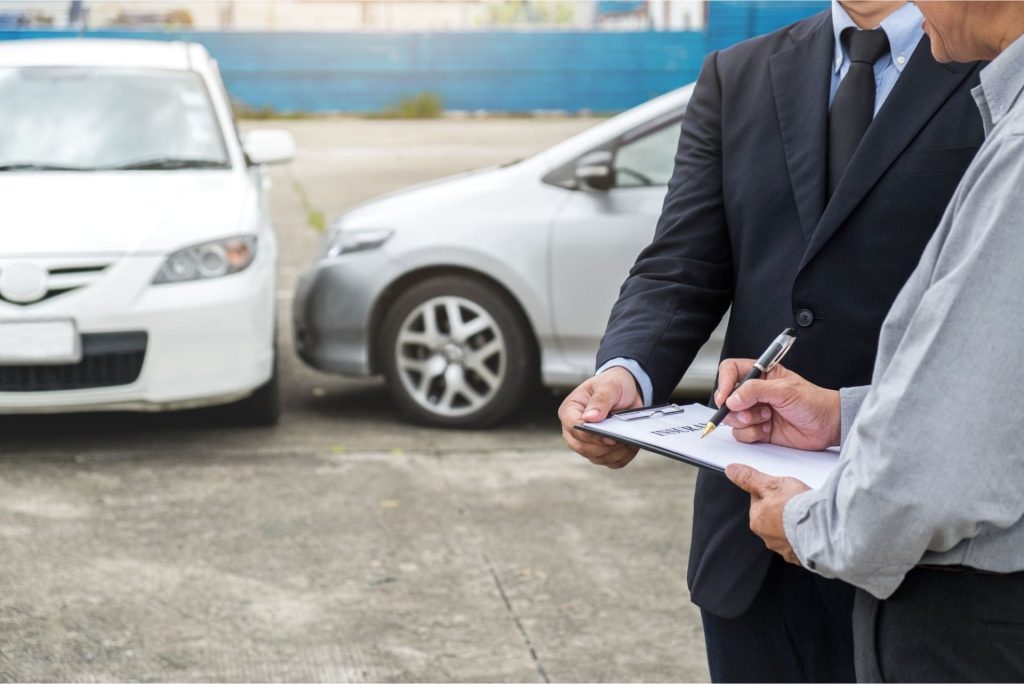
Written on August 18, 2022.
Written by James J. Kirshbaum. Posted in Car Accidents.
After you suffer a serious injury in a car accident, all you want to do is get the money you deserve so you can focus on recovering from your injuries and get your life back. That gets very difficult when the insurance company fights you every step of the way. You are facing expensive medical treatment, and the settlement they are trying to make you sign off on will not even cover medication. You have filed all the forms and reports they demanded, but you still have not heard anything back about when your insurance claim settlement check might arrive.
There could be many reasons why the insurance company is moving so slowly or delaying your settlement. In the end, insurance adjusters are nobody’s friend, and your best bet is to seek representation from an experienced car accident attorney like those from Kirshbaum Injury Law. Our law firm will advocate on your behalf and push to get the fair settlement and fair compensation you deserve.
What Is the Settlement Process for a Minnesota Car Accident Claim?
Minnesota is a no-fault state for car accident lawsuits. This means auto accident victims here must file their claim with their own insurance company, which begins the settlement process pending any potential lawsuit against the at-fault driver or liable party or parties. Your insurance company then investigates and determines whether your claim is settled or denied. If the settlement is accepted, you will receive a settlement offer.
You can sign off on this offer, but often it will be a very low settlement amount and won’t begin to cover your property damage and medical bills. No matter what they tell you, and no matter how much they threaten you or try to use your insurance policy against you, it is a bad idea to sign off on this initial payout offer. So long as you do not accept it, the offer can be challenged.
Conditions to File a Car Accident Personal Injury Lawsuit
You can only file a lawsuit against the other party’s insurance company in Minnesota if you meet certain requirements under state law. These include exceeding $4,000 in medical expenses not including diagnostic testing (MRI Scan, X-Ray, etc…) disfigurement (scars), permanent injury after maximum medical improvement or 60 days of disability resulting from the accident.
It’s important to get this all sorted quickly, as Minnesota has a statute of limitations of six years after the car crash to file your car accident lawsuit. For this reason, the sooner you file your suit, the better chance you have of getting full and fair compensation for the injuries you’ve suffered, from medical care to pain and suffering and beyond.
The Process of Settlement
Settling your motor vehicle accident lawsuit begins when you seek a free consultation from a qualified personal injury law firm. Your personal injury attorneys will review your case and provide you with advice on how to proceed. Next, your lawyer will build a case using your medical records, any police report from the scene that you have filed, and other evidence to build a strong argument that your personal injury claim is valid and you deserve maximum compensation. In some cases, depositions from witnesses can form part of the case.
Your personal injury lawyer will then issue a demand letter to the insurance company outlining the injuries you’ve suffered and exactly why your case is worth what you are demanding. The other side will then issue a response letter picking apart the demand, and countering with a lowball offer. From there, a back-and-forth process of negotiation takes place until both sides reach a middle point that satisfies everyone.
Getting to this middle point in a personal injury lawsuit, however, can take some time to accomplish and requires knowledgeable representation from a Minnesota personal injury lawyer who knows how to fight back against insurance companies. Contact an experienced lawyer at Kirshbaum Injury Law at (952) 545-2700 or through our contact form today to get a free consultation.
What Is the Average Amount of Time for a Car Accident Settlement in Minnesota?
No two personal injury cases are the same, and every personal injury lawsuit has its own unique issues to deal with. Because of this, every claim process takes a different amount of time. It depends on external factors from the existence of police and witness reports to detailed documentation of medical issues or property damage. The insurance company has a great deal to do with things as well. In the best of all cases, your provider reviews your insurance policy, agrees to your claim, and issues an acceptable check. The process in this case can take as little as a few weeks.
Unfortunately, cases rarely proceed this way, and insurance settlements can often take years to resolve. The worst-case scenario involves a court fight for your rights, though most cases do settle out of court because going to court is not in anyone’s best interests.
What is important, however, is that sometimes it can take from months to years to settle. In the meantime, your car accident personal injury lawyer is your greatest ally in your fight for compensation. Your attorney will be a kind and compassionate ear when you need it. They will give you legal advice and guidance and may be able to help you with resources to cover your medical costs and lost wages while they fight for you. Your lawyer will always keep you apprised of the status and keep you as involved as you like. They can take on the fight for payout while you focus on the fight to get well again.
What Are the Most Common Reasons for Delays in Minnesota Car Accident Claims?
There are many reasons why car accident claims might be delayed. These include:
- Maximum medical improvement
- High claim value
- Insurance company delays
- Legal representation
- Issues of fault
- Limits on insurance policies
Maximum Medical Improvement
Sometimes, to reach the proper settlement, it becomes necessary to wait until you reach a point of maximum medical improvement. This means you have hit a place where you are well again or where you won’t get any better. Reaching this point helps to put a cap on how much your medical bills will cost in total.
High Claim Value
If your claim has a particularly high value, it is likely the other side will fight much harder to significantly lower it. This can drag out negotiations. Some of the highest-value claims do end up having to go to court because insurance companies just don’t want to pay out the full value. Still, it’s often worth the fight and delays to get to the end.
Insurance Company Delays
Insurance companies will often try to drag out settlements. They hope that either the statute of limitations will run out so they do not have to pay, or that you will get tired of the fight and simply accept whatever they put on the table. Sadly, both scenarios do occur frequently. That’s why it’s important to have an experienced Minnesota car accident attorney in your corner.
Legal Representation
Legal representation on both sides can extend a settlement negotiation. This is because attorneys always want to represent the best interests of their clients, which can lead to one or both sides refusing to give ground on one or more issues. When this happens, other avenues include mediation and arbitration, or even a full court trial.
Fault Disputes
Sometimes, as in a truck accident, multiple parties may hold some blame for the accident, meaning multiple providers may come into play. This situation can drag out settlement negotiations as many different entities try to shift the blame on each other.
Minnesota is also a modified comparative fault state for personal injury lawsuits. What this means is if you hold any fault, your settlement will be reduced by a like amount. Thus, if your settlement is worth $200,000 and you are 25% responsible, you can only be awarded $150,000. Worse, if you are 51% or more responsible, you cannot get an award at all. That makes it essential for your car accident attorney to build an iron-clad case to prove you did not cause the accident.
Insurance Policy Limits
Insurance policy limits are a major factor in these cases. If the at-fault party’s insurance has a $100,000 limit and your case is worth $200,000, they will only pay up to the limit. The other party is technically still on the hook for the rest, but if they don’t have it to pay, you may never see it. Finding ways to get around policy limits can be time-consuming.
What Is the Impact of Settling a Car Accident Case Early?
Insurance companies want you to settle early. An early settlement usually means you signed off on one of the lowball offers they tendered. They depend on your extreme, immediate need to lead you to accept less money than you deserve. In the end, however, this short-term solution can leave you out in the cold as the medical bills continue to pile up. Don’t give in early. Instead, contact Kirshbaum Injury Law for a free case review at (952) 545-2700, or complete our contact form today and find out what your case might really be worth.
Why Involve a Car Accident Lawyer in Minnesota?
Legal representation helps make sure you have someone who will fight to see that your rights are protected. A lawyer will treat you fairly and work doggedly to get the money you deserve. The insurance companies have lawyers working for them. Why not have someone in your corner who knows the law just as well to fight back? A personal injury lawyer versed in car accidents might be the best call you make.
Don’t Settle for Less Than You Deserve
If you’ve been hurt in an accident and your insurance company is dragging on the settlement, do not forego legal representation. Legal help is only a phone call away. Contact Kirshbaum Injury Law today by calling (952) 545-2700 or by filling out our easy online contact form to get your free case evaluation with no disclaimer and no obligation. Let us fight for the compensation you deserve.

Written By James J. Kirshbaum
Jim is a very experienced trial lawyer having conducted jury trials in multiple states both on behalf of injured people and on behalf of defending insurance companies.
Schedule a Free Consultation with James J. Kirshbaum
What to Do if You Slip and Fall in a Store

Written on August 18, 2022.
Written by James J. Kirshbaum. Posted in Premises Liability.
If you have ever fallen in public or in the presence of others, you know the embarrassment and pain that comes with it. It gets even worse when it couples with a serious personal injury. A simple fall on a wet floor at the grocery store, tripping on walkways, or a tumble due to an unlabeled hole in a parking lot can mean broken bones, torn ligaments, high ankle sprains, and more.
You should not have to be worried about potential risks on other people’s property. When a fall happens and you get hurt, we are here for you. Learn what to do if you slip and fall and how a slip and fall attorney at Kirshbaum Injury Law can help your injury claim.
What Happens When You Slip and Fall on Someone Else’s Property?
Fall cases can occur due to dangerous conditions and neglect on the part of the store owner or property manager, which can take many forms. If there is any risk or hazardous situation and the property owner or store manager knows about it, they must address the danger. If they fail to do so, and you have a slip and fall accident resulting in serious injuries, you may have a premises liability claim. Be sure, however, to take the following steps after the accident.
Seek Medical Attention
The first step is to seek medical attention. Get seen immediately, even if you do not think you were seriously injured. Many injuries take days, weeks, or even months to present symptoms, and seeking medical treatment right away can stop an injury from getting worse. Seeking medical care can also show that you are taking your injury case seriously from the start.
File an Incident Report
An accident report is essential. Make sure that the store takes detailed notes describing exactly what caused your slip and fall accident and how the accident happened. These reports can be important as your personal injury lawyer builds your case. You might also want to take photos of the scene yourself and get a phone number or contact information from witnesses willing to testify to what they saw.
Contact an Attorney
Personal injury attorneys can be essential as you deal with the store’s insurance company. You will need to preserve evidence quickly. Most public places have surveillance, and copies of the footage can be essential in backing up your side of what happened in your slip and fall accident. If you do not move quickly, however, the footage can be wiped. An attorney can help build a strong case by putting together evidence and records. You can get a free case evaluation from Kirshbaum Injury Law. Call our legal team at (952) 545-2700 or complete our online contact form today.
What Is the Statute of Limitations for Slip and Fall Cases in Minnesota?
Minnesota has an extended statute of limitations compared to other states. In this state, we have six years from the accident date to file a personal injury claim. In cases of wrongful death, the clock begins ticking on the date of death. Just because the state has a long timeframe, however, does not mean that you should wait. In fact, just the opposite is true. Some people think it is better to wait until they have a more extended period of medical bills and medical records, but it is almost always better to file as soon as possible. The longer you wait, the older the evidence gets, and you could lose critical access to things like video footage.
Do You Have to Prove Negligence in a Premises Liability Claim?
Negligence is the core factor in a premises liability or slip and fall claim, just like in every injury claim. It means that when you suffer a fall injury, it must be tied back to some failure to exercise reasonable care by the property owner or manager.
To prove negligence, injured people must demonstrate that there was a danger present, that those responsible for the property knew about it or should have known about it, and that they failed to take reasonable action to address the danger.
What Types of Cases Fall Under Premises Liability?
Many incidents can result in accident victims filing a premises liability case. The core concept in this type of injury case is that the injury is related to a risk on a property that someone else was responsible for maintaining, and that person failed to take action to address the threat. A few types of premises liability cases follow.
Slip and Fall
Slip and fall cases are some of the most common types of premises liability accidents. If you encounter a wet floor in the grocery store, oil on the floor at a restaurant, or an icy parking lot, which causes you to slip and fall, you may be eligible for compensation.
Dog Bites
If you are visiting someone’s home and their dog bites you, they may be responsible. Homeowners are responsible for securing their pets and ensuring they are not a danger to others.
Inadequate Maintenance of the Premises
If you trip and fall in a parking lot where the concrete is filled with potholes or cracks, you could have a case. If you’re climbing a staircase where the carpet is loose, it could be a case.
Swimming Pool Accidents
Some of the most tragic premises liability cases involve children drowning in swimming pools that were not adequately secured. Any time a swimming pool accident occurs because the owner fails to take reasonable precautions, from slippery decks to unsecured access, it can be a premises liability case.
What Should You Not Do If You Slip and Fall in a Store?
It’s vital if you slip and fall in a store that you do not move immediately. Take stock of your situation and make sure you avoid critical mistakes.
Do Not Move if Injured
If you are hurt, do not move without the okay from medical professionals. Have the store call for first responders and let them make the decision.
Do Not Miss Medical Appointments
Never miss a medical appointment. Missing medical appointments could make your injuries appear less severe than you claim.
Do Not Admit Any Fault
Never apologize for anything at any time. Any time you say, “I’m sorry,” the insurance company will find a way to use it against you.
Do Not Attempt to Fight the Case Yourself
Don’t fight alone. Contact Kirshbaum Injury Law at (952) 545-2700 for a free consultation with no disclaimer and no obligation today.
Why Should You Contact an Attorney After You Slip and Fall?
If you or a loved one suffers a slip-and-fall accident, always contact an attorney. Your attorney can stand up and fight back against bullying insurance companies whose only goal is to avoid paying you what you deserve. The right injury lawyer knows how to build a case and combine evidence like video footage, medical records, and witness testimony to fight for your rights and advocate for you.
An even better reason is that the property owner and their insurance company have lawyers fighting for them. Having a lawyer of your own evens the playing field and gives you the best shot at significant compensation for the injuries you have suffered.
Let Us Be Your Advocates After You Slip and Fall
If you or a loved one has been hurt due to someone else’s negligence, you deserve to be compensated for the harm you’ve suffered. Don’t sign off on the first lowball settlement offer the insurance company makes. At Kirshbaum Injury Law, we always put our attorney-client relationship first and do whatever we can to help injured victims. Call us at (952) 545-2700 or fill out our online contact form for a free case review today.

Written By James J. Kirshbaum
Jim is a very experienced trial lawyer having conducted jury trials in multiple states both on behalf of injured people and on behalf of defending insurance companies.
Schedule a Free Consultation with James J. Kirshbaum



